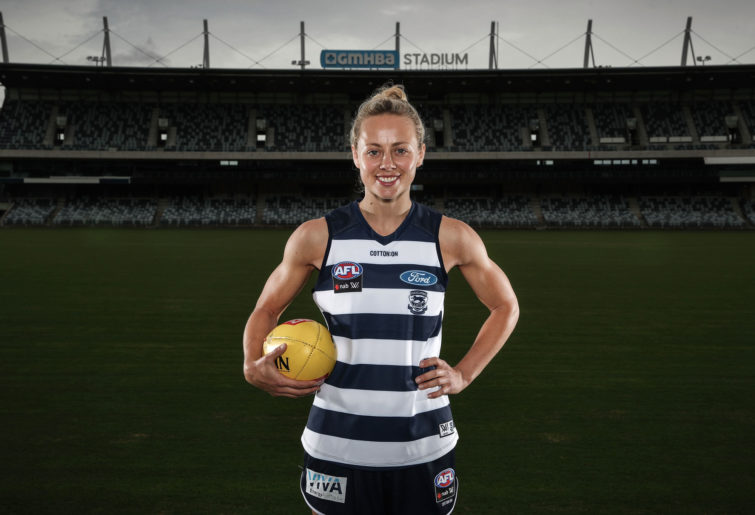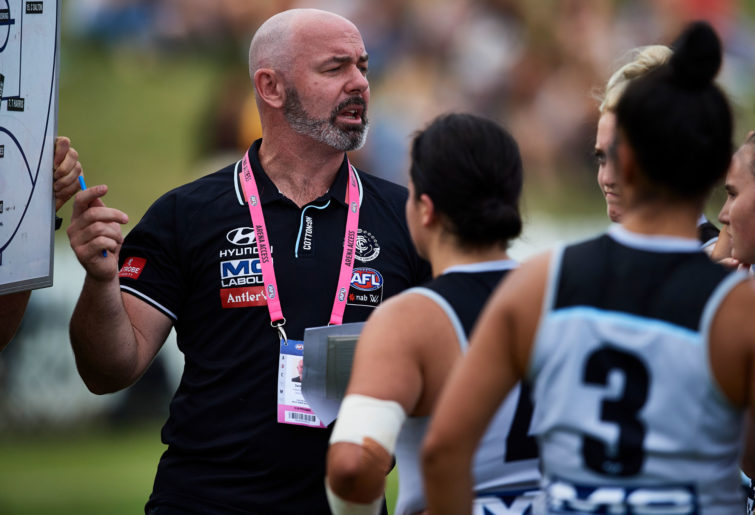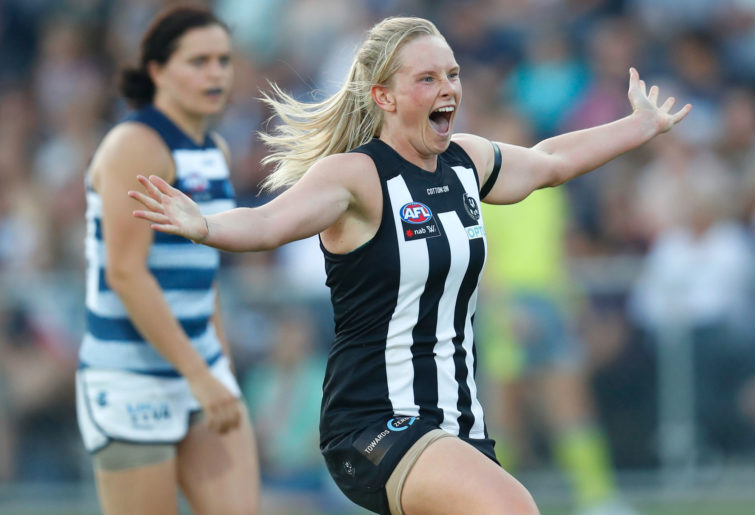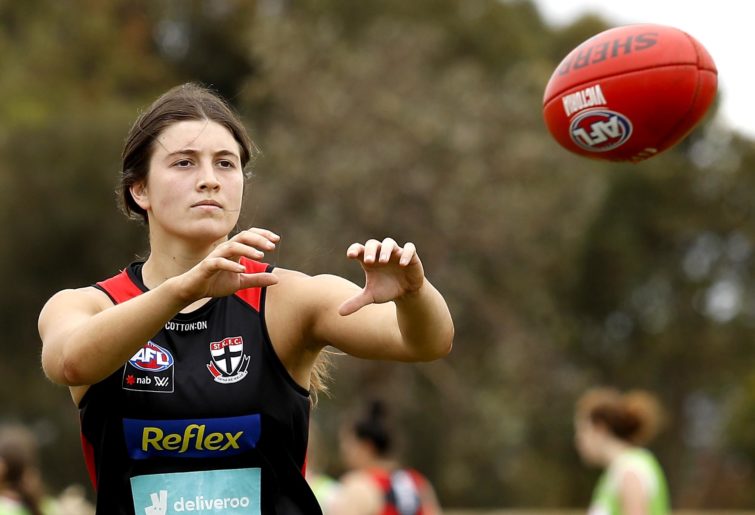The data says Brisbane are a flag contender - but the eye test tells a completely different story
There’s a slight disconnect between the data, the record and the eye test for the Brisbane Lions to start season 2024. This week, Champion…
Opinion
The AFLW season is mere days away and the excitement heading into another footy season is infectious.
With four new teams entering the competition this season, taking the total number to 14, the talent pool has been stretched even further, which could create a large gap between the best teams in the competition and the worst.
Conference A is expected to feature a couple of the top teams in the league this year, while Conference B is far too tight to definitively call, with a number of good teams sure to miss out on finals.
Overall, the 2020 season is sure to be fascinating, with clubs fighting against small lists sizes, injuries and conditions that will create some of the best footy in AFLW history, and some of the worst.
Below is a club-by-club preview and conference predictions for the 2020 AFLW season.
1. North Melbourne
Despite the loss of Jess Duffin for the season, North Melbourne look well placed to set themselves for a premiership tilt in their second season. Tactically built on clean kicking and strong transitional play from defence to attack, North Melbourne were statistically dominant when controlling the game and unparalleled in terms of overall efficiency inside 50.
Emma Kearney and Jemma Bruton are the stars through the midfield, and we can expect to see Emma King spend a lot more time up forward as the main tall while surrounded by the dangerous likes of Sophie Abbatangelo, Jasmine Garner and Kaitlyn Ashmore to name a few. Expect Ash Riddell to emerge as a star of the competition through the midfield after playing just two games in her debut season, while the importance of clean use off half-back could see a breakout season for Nicole Bresnehan.
2. GWS Giants
Once again, the Giants look really good on paper but after their disappointing output in 2019, question marks will be present once again over the validity of such a high-finishing prediction. Alyce Parker will finish as a top-ten midfielder this season and should challenge for MVP honours, while I don’t expect another down season from important players Jacinda Barclay and Jessica Dal Pos.
Expect the Giants to use a tighter defensive structure that is more focused on guarding areas rather than players, given the one-on-one struggles Pepa Randall, Louise Stephenson and Tanya Hetherington experienced. In defending space, it should allow for more of the Giants to put more numbers into the contest and nullify the influence of key forwards. GWS have the midfield depth and an improved presence in the forward line to really put together strong performances all over the ground in 2020, and with a relatively nice fixture to start, the Giants should begin 3-1 and move on with great confidence.
3. Adelaide Crows
The dominant team of 2019, the Crows enter 2020 on the back burner, with six injuries having the playing list down to just 24 ahead of the start of the season. With the best player in the AFLW a part of the question marks ahead of the year, it adds another level of uncertainty for Adelaide, who have a few tricky games in the opening month of the season against St Kilda, Geelong and Carlton.

(Photo by Daniel Kalisz/Getty Images)
Last year’s success was built on an attacking mindset and a high number of players experiencing breakout years. Anne Hatchard was perhaps the most surprising and influential, becoming an inside beast for the Crows, averaging 19 disposals, 12 contested possessions and five clearances a game. With a whole host of dangerous mid-sized forwards, led by last year’s leading goal-kicker Stevie-Lee Thompson, the Crows haven’t lost any of their attacking flair or pace through the midfield. How the club navigates the murky waters to start the season with a number of injuries will define how successful 2020 will be. Chelsea Randall will be an enormous loss.
4. Richmond Tigers
Having recruited three huge AFLW names upon the announcement of the team’s inclusion in the competition in 2020, the Tigers made it clear that they would be looking to challenge for a flag immediately. Monique Conti is one of the best midfielders in the competition, Katie Brennan is supremely talented and will play in the centre, while Sabrina Frederick will dominate aerially in attack. The Tigers also secured plenty of high-end talent from their VFLW team, with young ruck Alice Edmonds, midfielder Grace Campbell and crafty forward Tayla Stahl-Smith standouts from the team. Kate Dempsey is definitely a player to watch in 2020 as a potential All Australian candidate.
Richmond became an efficient, attacking juggernaut in the VFLW last season, ranking in the top two for key measures such as points, scores from turnovers and scores per inside 50. The defence needs the most attention, with a lack of top-level experience standing out the most when looking through the squad. Expect plenty of high-scoring games when the Tigers play.
5. Geelong Cats
Geelong happened to sneak into the finals in the club’s first season in AFLW despite winning just three games due to the way the conferences were set up in 2019. Lacking any real attacking threat, the Cats were exposed when they played the powerhouse of the competition in the finals, losing by an embarrassing 11 goals and needing to reassess their overall performance. Losing star draftee Nina Morrison never helped.
Season 2020 is already off to a rocky start with the club’s best player Meg McDonald out for a month due to a hand injury. The All Australian played the back end of 2019 with a fracture in her foot and will be sorely missed to start this season.
With a reasonable midfield group, sure to be assisted by Morrison and a fully fit Renee Garing, Geelong should remain competitive in the centre line. However, McDonald’s absence in defence along with a couple of really hard games in the opening month of the season will likely put the Cats on the back foot, and it’s unknown whether they can be competitive enough in attack to stay relevant.

Renee Garing. (Photo by Scott Barbour/AFL Media/Getty Images)
6. Gold Coast Suns
Another one of the new expansion clubs to join the competition, the Suns will be hoping to have a more successful entry into AFLW than their men’s team did in the AFL. Recruiting heavily from the Lions and locally, Gold Coast have set themselves up as one of the league’s younger teams, with the experience coming from coach David Lake (former Lions assistant) and the likes of Leah Kaslar (Lions), Sam Virgo (Lions) and Tiarna Ernst (Bulldogs).
The Suns’ young talent is full of potential and unlike what we have seen from previous Gold Coast teams, the ground work has been put in for each player to blossom fully in quick time. Ellie Hampson enters the league as a junior intercepting star, Serene Watson will be a well-rounded defender and Jacqui Yorston made a huge impact in her debut season at AFLW level with the Lions. The veteran experience will help fast-track the development of the youth, but the Suns shouldn’t be expected to be a threat in their first season.
7. Brisbane Lions
Hindsight is a brilliant thing, and if the Lions had won one of the two grand finals they narrowly lost, perhaps they wouldn’t be rated as the team most likely to struggle in 2020. Reality has set in though, and Brisbane will be lucky to notch up multiple victories this season. Having lost 155 games of experience according to Champion Data, the Lions are a shell of their former selves and will need to consider entering a full rebuild in order to make the most of the current situation.
The off-season struggles meant Brisbane was able to draft Lily Postlethwaite and Isabel Dawes inside the draft’s top 15, both of whom are elite prospects that should play straight away alongside the impressive Alexandra Anderson and Emily Bates. Kate Lutkins is the defensive pillar that Brisbane need, while the most dangerous forward Jess Wuetschner is still recovering after being struck by lightning. There are many holes in this Brisbane team and Queensland footy will struggle as a result.
1. Carlton
Runners-up in 2019 after a wooden spoon in 2018, coach Daniel Harford turned the Blues’ fortunes around with a positive mentality and maximising the skills of each player. Having started off the season with a couple of heavy losses, Carlton looked a completely different outfit following Round 3’s 29-point win over GWS and never looked back, largely thanks to improvement from the likes of Alison Downie, Kerryn Harrington and Gabby Pound.

(Photo by Brett Hemmings/Getty Images)
While Bri Davey has moved to the arch rivals, the Blues were able to draft Lucy McEvoy to create the highest-potential duo in the competition alongside Madison Prespakis, and this alone will give fans plenty of excitement going forward. Perhaps the one area that seemed to be lacking in 2019 was reliability in attack and by earmarking Nicola Stevens as the player to make the move into the forward line in 2020, Harford has created a team that has no glaring weakness and should be adaptable to any conditions, and any opposition. The Blues are in the tighter conference, but this is a club that can definitely challenge for the flag in 2020.
2. Fremantle
With four of their first five games in Perth, Fremantle are poised to get off to a flyer in 2020, which will make all the difference in a difficult conference. Home-ground advantage has proven to be important in AFLW in the competition’s infancy, and the Dockers should be making the most of it, getting off to a 4-1 start if things go well. Despite losing nine players to the Eagles, Fremantle still have their quality core that was incredibly disappointing in the loss to Carlton in the 2019 finals series.
In what will be her second season, Kiara Bowers is the inspirational midfield leader that will help the likes of Stephanie Cain, Hayley Miller and a debuting Jasmin Stewart become an impressive and versatile midfield core in 2020, which should help Kara Antonio recapture her best form. Gemma Houghton might be the most underrated key forward in the competition while Ebony Antonio could move back into defence and help Tayla Bresland, paving the way for Roxanne Roux to slot straight into the forward line. The obvious issue with the Dockers is the fact Irish recruit Aine Tighe injured her knee, leaving 18-year-old Mim Strom as the only ruck on the list.
3. Collingwood
With all the focus on there now being 14 teams and less pressure on those who failed previously, we can expect Collingwood to push for the finals in 2020. Chloe Molloy’s return cannot be understated, as she can easily be the competition’s best player with a full season and full fitness. Molloy is expected to play through the middle and in attack this season, which will make the Magpies extremely watchable. Sharni Layton should take on a greater role in the ruck this season, with her raw athleticism sure to catch the eye, while the recruitment of former Carlton skipper Bri Davey is sure to make her one of the most watched players in the competition.
Collingwood clearly identified early last season that with the lack of personnel, building from the back was the way forward. With a strong, tight defence in place, the Magpies have focused on improving the midfield and forward line for 2020, given the statistical nightmares that presented themselves last season. According to Champion Data, Collingwood were ranked last in disposal differential and time in possession, which is why the focus on defence was so critical. A new season has presented itself and with new focus, expect the Magpies to become a much-improved team, with Sarah D’Arcy finally becoming a star forward.

Sarah D’Arcy. (Photo by Michael Willson/AFL Media/Getty Images)
4. Melbourne
Much like the Crows, Melbourne are another highly rated team that enter this season with a lot of unknown thanks to unfortunately timed injuries. Lauren Pearce is perhaps the team’s most important player as the recognised ruck, and she isn’t expected to be available until mid-competition, while Lily Mithen and Tegan Cunningham are also missing the early parts of the season through injury.
The Demons struggled with a leaky defence and at stoppage situations. Signing defender Libby Birch from the Bulldogs is a clear indicator that Melbourne are looking to tighten their back line, while the return of inspirational leader Daisy Pearce may give the entire midfield group the kick it needs to win the hard ball again. With key absences in the middle and attack, however, this Demons team may fail to meet expectation. Commencing the season with games against North Melbourne, Western Bulldogs, St Kilda and Collingwood, Melbourne could be ruled out of finals contention early.
5. St Kilda
Unlike the bottom half of Conference A, finishing fifth could be a matter of being a small percentage point outside finals for the Saints, who could be the best of the expansion clubs. Under inspirational coach Peta Searle, this is a team built off the back of a strong VFLW team and signing plenty of AFLW experience, rather than big-name recruits like Richmond. Nat Exon, Kate McCarthy, Cat Phillips and Jess Sedunary bring quality AFLW experience with differing levels of success, while young guns Georgia Patrikios and Olivia Vesely will post big midfield minutes and forge their own paths to stardom sooner rather than later.

Georgia Patrikios. (Dylan Burns/AFL Photos via Getty Images)
The significance of having Peta Searle as coach cannot be understated. One of the most decorated coaches in VFLW history and with plenty of other experience in the AFL and VFL, Searle will get this group playing as a cohesive unit almost immediately, and there will be plenty of buy-in from the players. It’s an intangible factor that could go a long way in causing a few upsets for the Saints, who will likely push for finals.
6. Western Bulldogs
It all went wrong for the 2018 premiers, who lost their last five games of 2019 and ended up a shambles heading into the off-season. Things were made worse when Katie Brennan and Monique Conti joined Richmond, while Libby Birch and Tiarna Ernst found their way out the door despite being regulars. All these departures saw the Bulldogs pick up a few high-end draft picks, selecting gun midfielder Gabby Newton (pick one), influential forward Nell Morris-Dalton (pick six), outside midfielder Gemma Lagioia (pick eight) and flanker Elisabeth Georgostathis (pick nine).
With former number one pick Isabel Huntington sliding in like a recruit playing behind the ball, and midfield star Ellie Blackburn sticking around, the Bulldogs have a young core that should excite fans of the club and the competition alike. Defensive issues are likely to be prevalent for the Bulldogs in 2020, with the loss of Birch not covered, which places more defensive responsibility on Hannah Scott. This is likely to create a disjointed connection between the different sections of the field and new coach Nathan Burke will have a lot of work to do to fix this in just one season.
7. West Coast Eagles
The fourth expansion club joining the competition in 2020, the Eagles went and raided the Dockers for nearly a third of the club’s playing list as expected, but only walked away with one quality player (Dana Hooker) and one decent role player in the Tom T Lynch mould (Ashlee Atkins). The rest of the recruitment was puzzling for a team that wants to be competitive immediately, with very little key position experience at either end, instead relying on midfielders and smaller forwards to do the job.
Understandably, there is a lot of excitement surrounding the signing of McKenzie Dowrick, who may well turn into one of the best rebounding defenders in the competition, while Imahra Cameron is the most exciting player drafted last season. These are the standouts from what is otherwise a relatively uninspiring group at either end of the field, and skipper Emma Swanson, alongside Hooker, will need to do a lot of work around the ground in order to make the Eagles competitive.
Premiers: Carlton
MVP: Alyce Parker
Leading goal-kicker: Tayla Harris